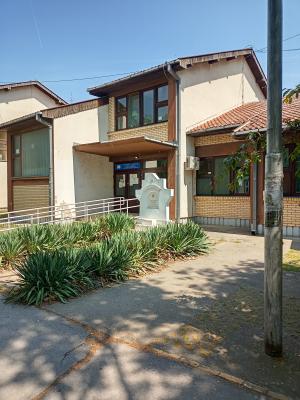Obj. ID: 8089
Modern Jewish Art Memorial at the Site of the Demolished Neolog Synagogue in Senta, Serbia, 2001
To the main object: Ashkenazi (Neolog) Synagogue in Senta

Memorial Name
No official name
What is Commemorated?
The demolished Neolog synagogue in Senta
Description
The monument’s shape is reminiscent of a six-pointed star if the bottom point has a flat base. The upper section, or the top end of the star, features a small circular bas-relief with a representation of the synagogue. Below is an arched inscription in Hebrew engraved on a stone panel. Beneath that, on the main body of the monument, is a panel with commemorative inscriptions in three languages: Hebrew, Hungarian, and Serbo-Croatian. The memorial is coated with blue and white mortar.
Inscriptions
The arched inscription (Hebrew):
זה ה שער לה' צדיקים יבאו בו
Translation: This is the gate to God through which the righteous will come
On the central panel
Hebrew
בכאן במקום הזה היה בית הכנסת הגדול
אשר נבנה בשנת תרל"ג לפ"ק
ונהרס בשנת תשי"ז לפ"ק
Translation: Here in this place was the Great Synagogue which was built in the year 5633 [excluding thousands] and was destroyed in the year 5717 [excluding thousands].
Hungarian
Itt állt az egykori Nagyzsinagóga.
Épult 1873-ban, lebontották 1957-ben.
Translation: The former Great Synagogue stood here. Built in 1873, demolished in 1957.
Serbo-Croatian
Na ovom mestu je stajala Velika sinagoga,
podignuta 1873. godine, a srušena 1957. godine.
Translation: The Great Synagogue stood in this place, built in 1873 and demolished in 1957.
Commissioned by
The Municipality of Senta
sub-set tree:
Mortar
Cement
The first Jews settled in Senta in the late 18th century. The community, Hevra Kadisha, prayer house, and school were established in the first half of the 19th century. The synagogue was erected in 1806. The cemetery was officially founded in 1852, although there are older monuments dating back to 1785. Those were transferred from the old cemetery that stood on the coast of the Tisza River. In 1855, a part of the members separated and established an orthodox community that had its own synagogue and mikveh. There was also a small Status Quo community, which was basically followers of Sighet Hasidism.
The new Neolog synagogue with an internal school was built in 1873. There was also a religious school Talmud Torah. The formal division between the two communities occurred in 1915. The Jewish Cultural Center was built in 1925 and the new Orthodox synagogue was built in 1929. In the 1920s, there were 1327 Jews living in Senta, the majority belonged to the Orthodox community. The number of Holocaust survivors is 276.
The two religious communities probably merged in 1950 or 1951 due to the small number of people, while the Status Quo community survivors all left in 1948.
In the 1950s, the Senta Jewish community sold both the Neolog Great Synagogue and the Sephardic (Orthodox) Small Synagogue to the city. The small synagogue was converted into a physical education hall. The Orthodox synagogue (23 Boška Jugovića Street) still exists and has been recently renovated and serves as a cultural center.
The community does not exist anymore.
The Neolog synagogue was built in a neoclassical style. What was unique about this synagogue is that it had towers. A few Jews who survived the Holocaust could not sustain the communal institutions and buildings on their own. The first victim was the large Neolog synagogue, standing without windows, and with a damaged roof structure. Therefore, on the grounds that it was not worth investing funds to restore the building, it was demolished in 1957.
This was not an isolated case. Eighty-two synagogues existed in the Vojvodina region before the Holocaust. Sixty-five were demolished; fifteen during and fifty-one after World War II, most in the period between 1948 and 1951. The answer to this lies partially in the fact that some of the buildings were damaged during the war and Jewish communities lacked the financial means to renovate them. Most communities vanished, and those who managed to reestablish themselves after the Holocaust were not only impoverished but also saw welfare activities as a priority. Therefore, Jewish communities and the Federation of Jewish Communities of Yugoslavia sold dozens of synagogue buildings nationwide and used the funds to support their members. While some of the synagogue buildings were repurposed, in Vojvodina the vast majority were destroyed.
The monument on the site of the demolished synagogue in Senta was unveiled in 2001. The inscription only acknowledges the existence of the synagogue, without mentioning what was the fate of the local Jewish community during the Holocaust.
The Senta municipality is maintaining the monument.
Pejin, Attila, A zentai zsidóság története. (Senta: Thurzó Lajos Közművelődési Központ, 2003)
"Senta/Zenta," Locations (Vojvodina Holocaust Memorials Project), https://www.vhmproject.org/en-US/Locations/Details/19 (accessed June 25, 2023)
Šosberger, Pavle. Sinagoge u Vojvodini: Spomanica minulog vremena (Novi Sad, 1998)
“Készítsenek nekem Szentélyt, hogy köztük lakjam! (2Mózes 25:8.),” Eugen, http://www.eugen.hupont.hu/81/keszitsenek-nekem-szentelyt-hogy-koztuk-lakjamfelavattak (accessed June 18, 2023)





















